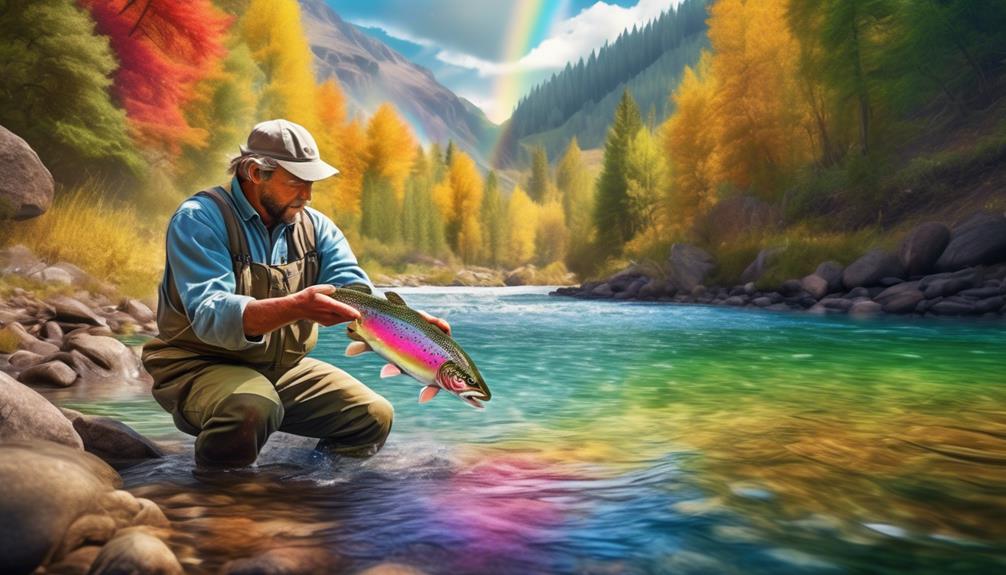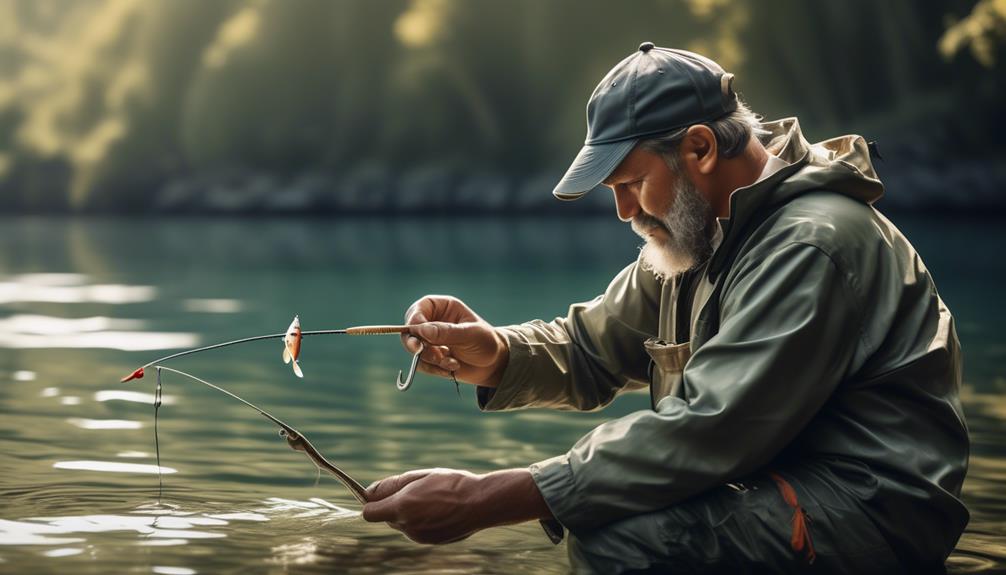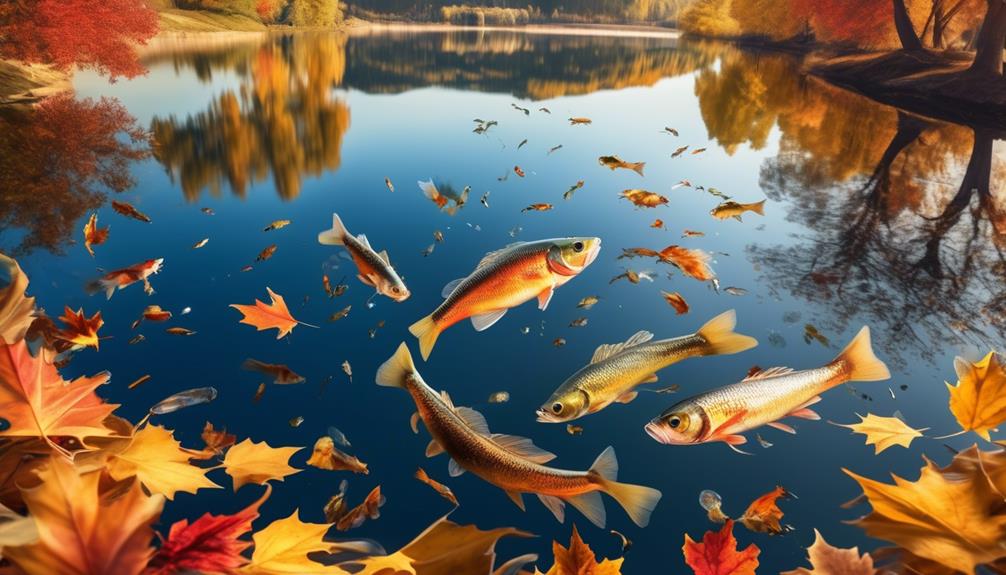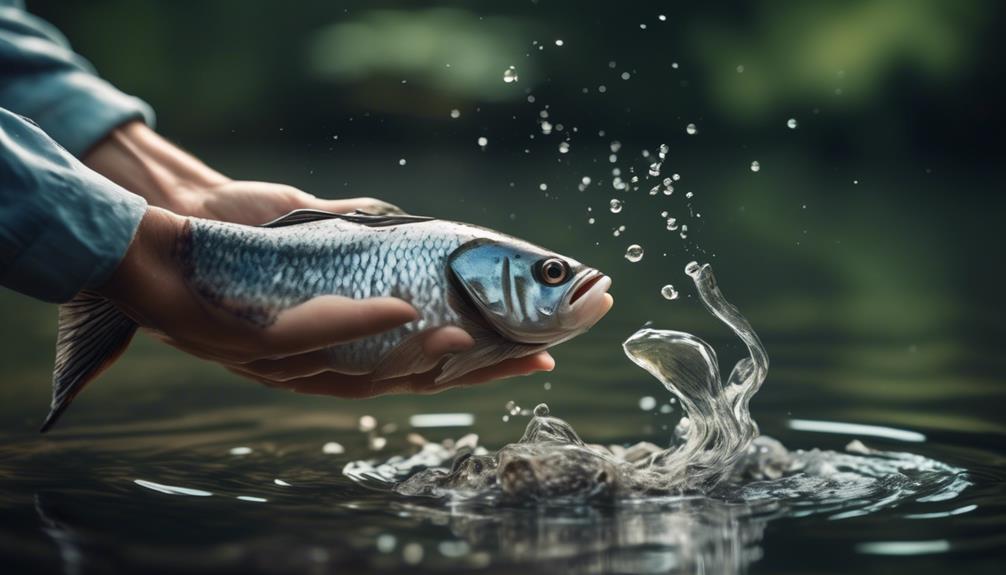Whether you're a seasoned angler or just starting out, the decision of which fish species to target for catch and release can be a complex one.
Each species presents its own set of ethical considerations and challenges, from the delicate nature of trout to the powerful fight of a tarpon.
As you navigate this decision-making process, it's crucial to weigh the impact of your choices on the overall health of fish populations and their ecosystems.
But how do you determine which species are best suited for ethical catch and release?
Let's explore the factors that come into play when making this important decision.
Bass
When fishing for bass, remember to handle them carefully to ensure their safe release back into the water. Catch and release techniques are crucial for the conservation of bass populations. When you hook a bass, try to minimize the fight time by using heavier tackle, which reduces exhaustion and stress on the fish. Keep the bass in the water as much as possible and use barbless hooks to facilitate an easy and quick release.
Avoid using a net unless absolutely necessary, as it can remove the protective slime layer from the fish, making them susceptible to infections. When handling the bass, wet your hands before touching them to avoid damaging their sensitive skin and scales. Supporting the fish horizontally provides better spine support and prevents internal injuries. Additionally, if the bass is deep-hooked, use long-nosed pliers to gently remove the hook, being mindful not to cause further harm.
Bass conservation efforts are reliant on the responsible practices of anglers. By adhering to catch and release guidelines, you contribute to the preservation of bass populations. It's essential to understand the environmental factors that affect bass habitats and their breeding grounds. By releasing bass unharmed, you allow them to continue contributing to the ecosystem's balance. Your commitment to ethical fishing practices ensures that future generations can also enjoy the thrill of catching these magnificent fish.
Trout
To ensure the ethical catch and release of trout, it's crucial to handle them carefully and minimize their stress when removing them from the water. When practicing catch and release for trout, conservation practices are essential to maintain healthy fish populations. It's vital to use barbless hooks that can be easily removed, reducing potential injury to the fish.
Additionally, always wet your hands before handling trout to protect their delicate skin and avoid removing their protective slime coat, which helps prevent infections.
Habitat preservation is equally important for trout conservation. When fishing, be mindful of the fish's environment. Avoid wading through spawning areas and disturbing their nests, as this can have detrimental effects on their reproduction. Also, be conscious of the water temperature, especially in warmer months, as trout are sensitive to temperature changes. If the water is too warm, it's best to avoid fishing for trout to prevent causing them stress due to the added strain of being caught and released in less than ideal conditions.
Conservation organizations and fishery management agencies often provide guidelines for ethical catch and release practices specific to trout fishing. By following these guidelines and staying informed about local fishing regulations, you can contribute to the preservation of trout populations.
Salmon
Salmon fishing requires understanding their behavior and habitat to ensure ethical catch and release practices. When pursuing salmon, it's crucial to prioritize their conservation. Responsible angling techniques play a vital role in safeguarding salmon populations.
Understanding salmon behavior is essential. They're known for their migratory nature, with many species returning to their native freshwater streams to spawn. To support salmon conservation, it's important to familiarize yourself with the specific regulations and guidelines for the region you're fishing in. These rules are in place to protect vulnerable salmon stocks and ensure sustainable fishing practices.
When angling for salmon, it's crucial to handle them with care. Always use barbless hooks, as they minimize injury and make for easier hook removal. Additionally, practicing proper catch and release methods is essential. This includes minimizing fight time, using a landing net to avoid damaging their scales, and keeping the fish in the water as much as possible. Avoiding over-handling and supporting the fish in an upright position can also aid in their swift recovery upon release.
Understanding the impact of factors such as water temperature and oxygen levels on salmon is crucial. Responsible anglers should be mindful of these environmental factors and avoid fishing in areas where salmon may be particularly vulnerable, such as during spawning periods.
Pike
Consider targeting pike, a formidable predator that offers anglers an exhilarating challenge. When fishing for pike, it's crucial to handle them with care to ensure their safe release. Using proper pike handling techniques, such as supporting their body weight, minimizing air exposure, and using barbless hooks, can significantly improve their chances of survival post-release. Conservation efforts for pike are also essential to maintain their populations. By staying informed about local regulations and participating in pike conservation initiatives, anglers can contribute to the preservation of this species.
Ethics of pike fishing also play a crucial role in minimizing the impact on local ecosystems. Practicing catch and release, using appropriate gear to prevent deep hooking, and avoiding pike during their spawning seasons are all ethical considerations for pike fishing. It's important to be mindful of the potential effects of pike fishing on the local ecosystem and take steps to minimize any negative impact. Additionally, being selective about the size and number of pike caught can help maintain a balanced predator-prey relationship within the ecosystem.
Tarpon
When targeting tarpon, ensure you handle them with care to maximize their chances of survival after release. Tarpon are a prized catch for many anglers due to their impressive size and acrobatic fighting ability. However, it's important to prioritize their well-being through ethical catch and release practices. Conservation efforts play a crucial role in preserving tarpon populations, and sustainable practices can help ensure their continued existence for future generations.
Conservation efforts aimed at tarpon focus on understanding their behavior, migration patterns, and habitat requirements. By gathering data on tarpon movements and preferred spawning grounds, researchers and conservationists can work to protect these vital areas. Additionally, sustainable practices such as using non-offset circle hooks and minimizing fight times can greatly increase the likelihood of a tarpon's survival after release. These small adjustments can make a significant impact on the overall health of tarpon populations.
When engaging in catch and release fishing for tarpon, it's essential to prioritize their well-being. This means handling them with care, minimizing air exposure, and releasing them quickly to reduce stress. By following these guidelines and supporting conservation efforts, anglers can contribute to the preservation of tarpon populations for the enjoyment of future generations. Remember, every small effort towards sustainable fishing practices can make a big difference in the long-term health of tarpon and their ecosystems.
Bonefish
Bonefish, known for their elusive nature and lightning-fast runs, require careful handling to ensure their survival after being caught and released. When practicing catch and release techniques with bonefish, it's crucial to minimize their time out of the water and handle them with wet hands to avoid damaging their delicate protective slime coat. This species is particularly sensitive to stress, so it's important to use barbless hooks to facilitate easy hook removal and minimize injury. Additionally, when releasing a bonefish, support it in the water until it's able to swim away strongly on its own.
In terms of environmental impact, bonefish play a significant role in the ecosystem as they're a key species in many coastal habitats. They're important for maintaining the balance of the food chain and contribute to the overall health of the marine environment. However, overfishing and habitat destruction have led to a decline in bonefish populations in some areas. By practicing ethical catch and release, anglers can help conserve bonefish populations and preserve the delicate balance of the coastal ecosystem.
Redfish
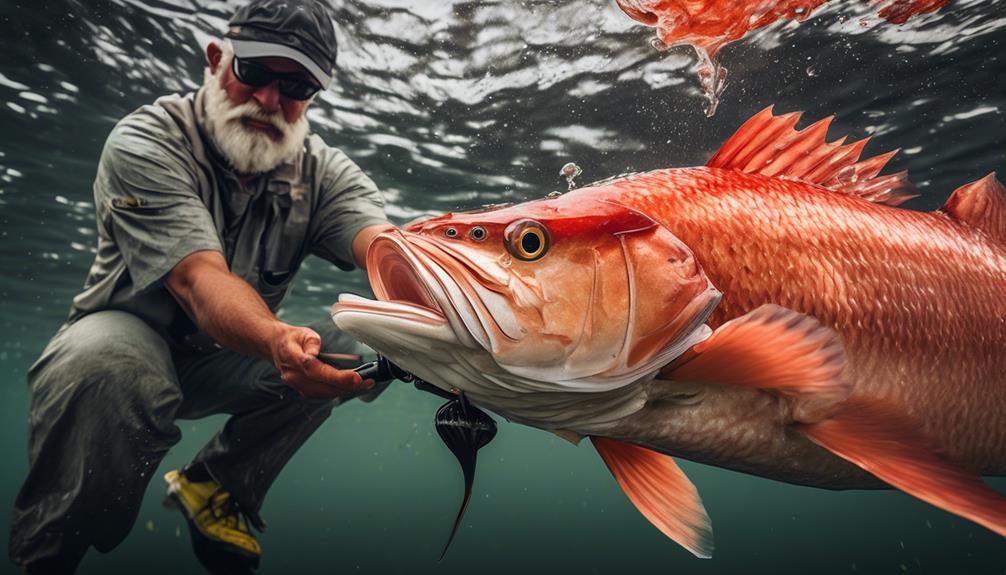
As you turn your attention to Redfish, another species known for its resilience and sporting challenge, it's important to be mindful of the transition from handling bonefish to the unique considerations of catching and releasing this species.
Redfish conservation is crucial for maintaining healthy populations, and ethical angling practices play a significant role in achieving this goal.
Redfish, also known as Red Drum, are popular among anglers for their powerful runs and fierce fighting spirit. When practicing ethical angling with Redfish, it's essential to handle them with care to ensure their survival post-release. Always wet your hands before handling a Redfish to protect its delicate mucous layer, which is vital for its protection against infections and parasites. Additionally, using barbless hooks can minimize the potential damage to the fish's mouth, facilitating a smoother release process.
Furthermore, understanding the local regulations and size limits for Redfish is crucial for their conservation. Adhering to these guidelines helps in preserving the breeding stock and ensuring the sustainability of Redfish populations for future generations of anglers. By releasing oversized or undersized Redfish, you contribute to the species' conservation and help maintain a balanced ecosystem.
Snook
Snook, also known as robalo, are sought after by anglers for their acrobatic leaps and strong, rapid runs. However, it's crucial to prioritize snook conservation and employ proper catch techniques to ensure their sustainability.
When fishing for snook, it's important to use barbless hooks and tackle that minimizes injury to the fish. This can help in releasing them back into the water unharmed. Sustainable snook fishing involves understanding and respecting regulations regarding catch limits and size restrictions. By adhering to these guidelines, you contribute to the overall conservation of snook populations.
Habitat protection is another key aspect of snook conservation. Snook thrive in a variety of habitats, including mangroves, seagrass beds, and estuaries. These habitats serve as nurseries for young snook and are essential for their survival.
When fishing for snook, it's important to avoid damaging these sensitive ecosystems. Be mindful of your surroundings and consider the potential impact of your actions on the snook's habitat.
Frequently Asked Questions
What Are the Best Practices for Handling and Releasing Bass, Trout, Salmon, Pike, Tarpon, Bonefish, Redfish, and Snook to Ensure Their Survival After Catch and Release?
When handling bass, trout, salmon, pike, tarpon, bonefish, redfish, and snook for catch and release, prioritize fish handling to reduce stress. Use barbless hooks and avoid removing the fish from the water. Minimize air exposure and support the fish during release.
These practices increase survival rates and promote ethical catch and release. Remember, proper fish handling and release techniques are crucial for the well-being of these species.
Are There Any Specific Regulations or Guidelines for Catch and Release of These Fish Species in Different Regions?
In different regions, there are specific regulations and guidelines for catch and release of various fish species. These rules help ensure the survival of the fish after release and protect the ecosystem.
It's important to be aware of the specific regulations in your area to responsibly practice catch and release. Understanding these guidelines can contribute to the environmental impact and the success rate of catch and release, backed by research data.
How Can I Effectively Revive and Release These Fish Species if They Show Signs of Distress After Being Caught?
If a fish shows signs of distress after being caught, effectively revive and release it by using proper reviving techniques. Recognize distress indicators like sluggishness or inability to maintain balance.
Successful catch and release greatly depends on ethical handling and reviving techniques. This approach minimizes environmental impact and improves survival rates of released fish.
Are There Any Particular Techniques or Equipment That Can Help Minimize the Impact of Catch and Release on These Fish Species?
To minimize impact and follow ethical practices when catching and releasing fish, consider using barbless hooks, circle hooks, and non-stainless-steel gear. Proper handling techniques like wetting hands before handling fish and using a rubber-coated net can also help.
Additionally, avoid keeping fish out of the water for too long and release them gently. These equipment options and handling techniques can help reduce stress and ensure the survival of the fish after catch and release.
Is There Any Research or Data Available on the Success Rate of Catch and Release for Bass, Trout, Salmon, Pike, Tarpon, Bonefish, Redfish, and Snook in Different Environments?
Research on success rates of catch and release for bass, trout, salmon, pike, tarpon, bonefish, redfish, and snook in different environments is available. Factors like water temperature, handling techniques, and hook types affect success rates.
Ethical considerations and conservation efforts drive the need for this data. Understanding how environmental factors impact these species' survival after release is crucial for responsible angling and sustainable fish populations.
Conclusion
So, when it comes to ethical catch and release, it's important to consider the species of fish you're targeting.
Bass, trout, salmon, pike, tarpon, bonefish, redfish, and snook are all great choices for catch and release.
By choosing these species, you can help ensure the health and sustainability of fish populations for future generations of anglers to enjoy.
Happy fishing!
